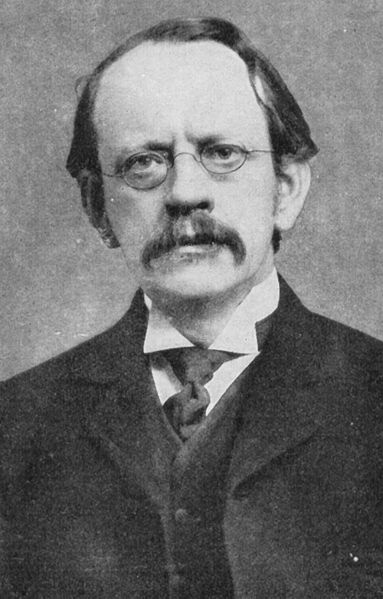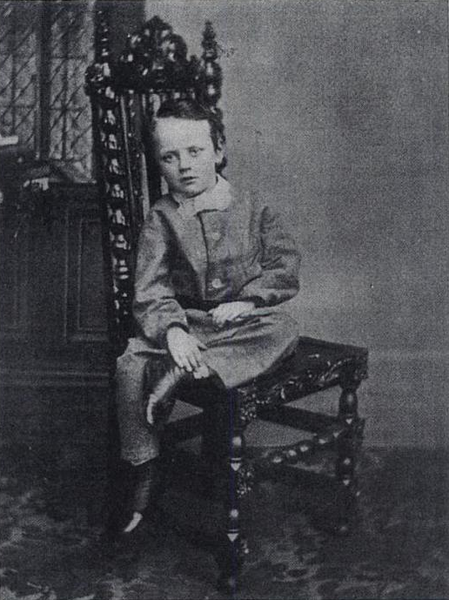<Back to Index>
- Physicist Joseph John "J.J." Thomson, 1856
- Painter Willem van de Velde the Younger, 1633
- Chancellor of Germany Willy Brandt, 1913
PAGE SPONSOR


Sir Joseph John “J.J.” Thomson, OM, FRS (18 December 1856 – 30 August 1940) was a British physicist and Nobel laureate, credited for the discovery of the electron and of isotopes, and the invention of the mass spectrometer. He was awarded the 1906 Nobel Prize in Physics for the discovery of the electron and his work on the conduction of electricity in gases.
Joseph John Thomson was born in 1856 in Cheetham Hill, Manchester, England. His mother, Emma Swindells, came from a local textile family. His father, Joseph James Thomson, ran an antiquarian bookshop founded by a great-grandfather from Scotland (hence the Scottish spelling of his surname). He had a brother two years younger than him, Frederick Vernon Thomson.
His early education was in small private schools, and demonstrated great talent and interest in science. In 1870 he was admitted to Owens College. Being only 14 years old at the time, he was unusually young. His parents planned to enroll him as an apprentice engineer to Sharp-Stewart & Co., a locomotive manufacturer, but these plans were cut short when his father died in 1873. He moved on to Trinity College, Cambridge in 1876. In 1880, he obtained his BA in mathematics (Second Wrangler and 2nd Smith's prize) and MA (with Adams Prize) in 1883. In 1884 he became Cavendish Professor of Physics. One of his students was Ernest Rutherford, who would later succeed him in the post. In 1890 he married Rose Elisabeth Paget, daughter of Sir George Edward Paget, KCB, a physician and then Regius Professor of Physics at Cambridge. He fathered one son, George Paget Thomson, and one daughter, Joan Paget Thomson, with her. One of Thomson's greatest contributions to modern science was in his role as a highly gifted teacher, as seven of his research assistants and his aforementioned son won Nobel Prizes in physics. His son won the Nobel Prize in 1937 for proving the wavelike properties of electrons.
He was awarded a Nobel Prize in 1906, "in recognition of the great merits of his theoretical and experimental investigations on the conduction of electricity by gases." He was knighted in 1908 and appointed to the Order of Merit in 1912. In 1914 he gave the Romanes Lecture in Oxford on "The atomic theory". In 1918 he became Master of Trinity College, Cambridge, where he remained until his death. He died on 30 August 1940 and was buried in Westminster Abbey, close to Sir Isaac Newton.
Thomson was elected a Fellow of the Royal Society on 12 June 1884 and was subsequently President of the Royal Society from 1915 to 1920. Until
1897, scientists believed atoms were indivisible, the ultimate
particles of matter, but Thomson proved them wrong when he discovered
that atoms contained particles known as electrons. Thomson discovered
this through his explorations on the properties of cathode rays.
Thomson found that the rays could be deflected by an electric field (in
addition to magnetic fields, which was already known). He concluded
that these rays, rather than being waves, were composed of very light
negatively charged particles which he called "corpuscles". (Later
scientists preferred the name electron which had been suggested by George Johnstone Stoney in
1894, prior to Thomson's actual discovery). Thomson believed that the
corpuscles emerged from the atoms of the trace gas inside his cathode ray tubes.
He thus concluded that atoms were divisible, and that the corpuscles
were their building blocks. To explain the overall neutral charge of
the atom, he proposed that the corpuscles were distributed in a uniform
sea of positive charge; this was the plum pudding model as the
electrons were embedded in the positive charge like plums in a plum
pudding (although in Thomson's model they were not stationary). In 1913, as part of his exploration into the composition of canal rays,
Thomson channelled a stream of ionized neon through a magnetic and an
electric field and measured its deflection by placing a photographic
plate in its path. Thomson observed two patches of light on the
photographic plate, which suggested two different
parabolas of deflection. Thomson concluded that neon is composed of
atoms of two different atomic masses (neon-20 and neon-22), that is to
say of two isotopes. This was the first evidence for isotopes of a stable element; Frederick Soddy had previously proposed the existence of isotopes to explain the decay of certain radioactive elements. Thomson's separation of neon isotopes by their mass was the first example of mass spectrometry, which was subsequently improved and developed into a general method by Thomson's student F.W. Aston and by A.J. Dempster. In 1905 Thomson discovered the natural radioactivity of potassium. In 1906 Thomson demonstrated that hydrogen had only a single electron per atom. Previous theories allowed various numbers of electrons.